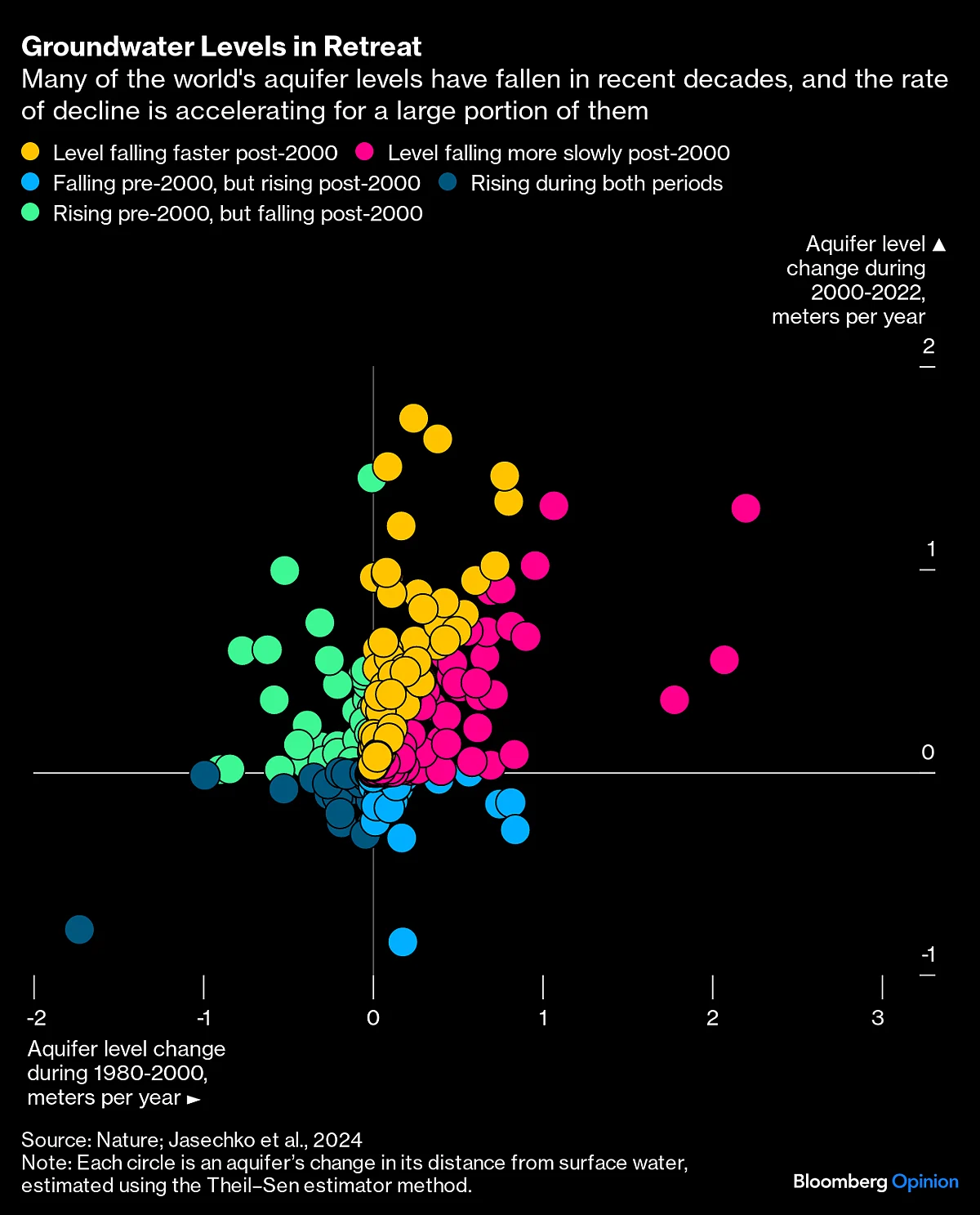Groundwater Is Vanishing Worldwide, But It Can Be Rescued
Some arid and heavily farmed places have managed to protect and even start replenishing their aquifers.

(Bloomberg Opinion) -- Unless thirsty aliens come and take it, Earth’s water isn’t going anywhere. It’s just becoming increasingly difficult for thirsty humans to access. But there’s reason to hope we can do a better job of that even as the planet warms.
The bulk of Earth’s water, about 97%, is in salty oceans and thus useless for drinking or growing food. Of the 3% that is fresh, most is locked in ice sheets and glaciers, many of which are melting rapidly into the oceans thanks to climate change. A relative few drops of fresh water are available in ponds, lakes and rivers, which are easily accessible but also vulnerable to pollution, overuse and drought.
Humanity’s biggest source of fresh water — representing just 0.8% of Earth’s total water — is in underground aquifers. Decades of drought, pollution and overuse are shrinking even that precious supply, and rising sea levels threaten to spoil even more of it with saltwater incursions. A recent survey of groundwater levels at hundreds of wells worldwide found that 71% have fallen since the start of the 21st century. Groundwater loss worsened at more than half of the studied wells during that time.

But the survey also revealed, encouragingly, that groundwater disappearance isn’t universal. Losses are most common in areas that are both dry and heavily farmed. Some of those places have managed to protect and even start replenishing their aquifers. The Abbas-e Shargi basin in arid southwestern Iran was losing groundwater at a rate of nearly a foot a year before the turn of the century, according to the study data. It has regained nearly 3 feet of water a year in the past two decades thanks to diverted water from the Karkheh Dam.
The Upper Santa Cruz basin near Tucson, Arizona, was drying up as quickly as the Abbas-e Shargi until water authorities started a campaign to recharge local aquifers. Using water from the Colorado and other nearby rivers, along with treated wastewater, many groundwater reservoirs in dry southwestern Arizona are now growing despite a warming climate and the worst megadrought in 1,200 years.
“Tucson was able to basically turn off some wells,” said Sharon Megdal, director of the Water Resources Research Center at the University of Arizona in Tucson, who was not involved in the study. “That water was no longer needed to serve the public because the city was storing and recovering surface water.”
Of course, surface-water supplies like the Colorado River increasingly have their own problems with climate, mismanagement, pollution, saltwater incursion and drought. They are no magic fountain for replenishing groundwater supply. Demand-side fixes — taxes, often, but also conservation drives — are necessary, too, even if they are more politically painful.
The Bangkok basin in Thailand, part of a system that supplies water to more than 11 million people, suffered from groundwater loss for decades — more than 2 feet a year between 1980 and 2000, according to the study data. The land under Bangkok was sinking, and the quality of drinking water was deteriorating.
Soon after the turn of the century, the Thai government started to ratchet up groundwater-use charges it had first imposed in the 1980s, increasing them from 3.5 baht per cubic meter to 17 baht. Lo and behold, local aquifers recovered, so much that the government was able to slightly lower the charges in 2012. Rising costs recently forced Thai authorities to raise rates for the first time in 23 years.
One thing Tucson and Bangkok have in common, aside maybe from relentless heat and beautiful landscapes, is what Megdal calls “water consciousness.” Both struggled to manage water supplies for a long time before finding solutions, making it easier to ask people to sacrifice. As the planet warms and rainfall becomes less predictable, more sacrifices are inevitable.
“Somebody in Tucson might say we use less water than others,” Megdal said. “But there’s still room to use even less. There are lots of actions authorities can take to stress the need to reduce water use.”
In some lucky places, nature will do much of the work: More than half the aquifers that have refilled since the turn of the century were in areas where rainfall had increased, according to the study. Unfortunately, such areas are increasingly rare. As the planet warms, more people will need to develop water consciousness: understanding the scarcity of this resource and, when necessary and done fairly, pricing that resource to reflect its true value.
More From Bloomberg Opinion:
- War Has Created a Huge Arctic Blind Spot: Lara Williams
- Forests Are Doing Much Better Than We Think: David Fickling
- ’24 Election Just Might Turn on … Climate Change?: Mark Gongloff
--With assistance from Elaine He.
This column does not necessarily reflect the opinion of the editorial board or Bloomberg LP and its owners.
Mark Gongloff is a Bloomberg Opinion editor and columnist covering climate change. He previously worked for Fortune.com, the Huffington Post and the Wall Street Journal.
More stories like this are available on bloomberg.com/opinion
©2024 Bloomberg L.P.